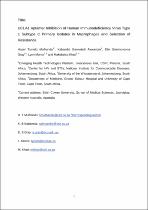 ResearchSpace
ResearchSpace
UCLA1 aptamer inhibition of human immunodeficiency virus type 1 subtype C primary isolates in macrophages and selection of resistance
JavaScript is disabled for your browser. Some features of this site may not work without it.
- ResearchSpace
- →
- Research Publications/Outputs
- →
- Journal Articles
- →
- View Item
| dc.contributor.author |
Mufhandu, Hazel T

|
|
| dc.contributor.author |
Alexandre, Kabamba B

|
|
| dc.contributor.author |
Gray, ES

|
|
| dc.contributor.author |
Morris, L

|
|
| dc.contributor.author |
Khati, M

|
|
| dc.date.accessioned | 2016-12-20T10:48:01Z | |
| dc.date.available | 2016-12-20T10:48:01Z | |
| dc.date.issued | 2016-09 | |
| dc.identifier.citation | Mufhandu, H.T., Alexandre, K.B., Gray, E.S., Morris, L. and Khati, M. 2016. UCLA1 aptamer inhibition of human immunodeficiency virus type 1 subtype C primary isolates in macrophages and selection of resistance. Biochemistry and Biophysics Reports, 7, pp 408–414 | en_US |
| dc.identifier.issn | 2405-5808 | |
| dc.identifier.uri | http://www.sciencedirect.com/science/article/pii/S2405580816301133 | |
| dc.identifier.uri | http://hdl.handle.net/10204/8892 | |
| dc.description | Copyright: 2016 Elsevier. This is a post-print version. The definitive version of the work is published in the Biochemistry and Biophysics Reports,7, pp 408–414 | en_US |
| dc.description.abstract | We have previously shown that the aptamer, UCLA1, is able to inhibit HIV-1 replication in peripheral blood mononuclear cells (PBMCs) by binding to residues in gp120. In this study we examined whether UCLA1 was effective against HIV-1 subtype C isolates in monocyte-derived macrophages (MDMs). Of 4 macrophage-tropic isolates tested, 3 were inhibited by UCLA1 in the low nanomolar range (IC80 <29 nM). One isolate that showed reduced susceptibility (<50 nM) to UCLA1 contained mutations in the a5 helix next to the CD4 and co-receptor (CoR) binding complex. To further evaluate aptamer resistance, two primary viruses were subjected to increasing concentrations of UCLA1 over a period of 84 days in PBMCs. One isolate showed a 7-fold increase in IC80 (351 nM) associated with genetic changes, some of which were previously implicated in resistance. This included F223Y in the C2 region and P369L within the CD4 and CoR binding complex. A second isolate showed a 3-fold increase in IC(sub80) (118 nM) but failed to show any genetic changes. Collectively, these data show that UCLA1 can efficiently block HIV-1 infection in MDMs and PBMCs with escape mutations arising in some isolates after prolonged exposure to the aptamer. This supports the further development of the UCLA1 aptamer as a HIV-1 entry inhibitor. | en_US |
| dc.language.iso | en | en_US |
| dc.publisher | ELSEVIER | en_US |
| dc.relation.ispartofseries | Workflow;17445 | |
| dc.subject | HIV-1 | en_US |
| dc.subject | gp120 mutations | en_US |
| dc.subject | Subtype C | en_US |
| dc.subject | UCLA1 | en_US |
| dc.subject | Aptamer | en_US |
| dc.subject | Monocyte-derived macrophages | en_US |
| dc.title | UCLA1 aptamer inhibition of human immunodeficiency virus type 1 subtype C primary isolates in macrophages and selection of resistance | en_US |
| dc.type | Article | en_US |
| dc.identifier.apacitation | Mufhandu, H. T., Alexandre, K. B., Gray, E., Morris, L., & Khati, M. (2016). UCLA1 aptamer inhibition of human immunodeficiency virus type 1 subtype C primary isolates in macrophages and selection of resistance. http://hdl.handle.net/10204/8892 | en_ZA |
| dc.identifier.chicagocitation | Mufhandu, Hazel T, Kabamba B Alexandre, ES Gray, L Morris, and M Khati "UCLA1 aptamer inhibition of human immunodeficiency virus type 1 subtype C primary isolates in macrophages and selection of resistance." (2016) http://hdl.handle.net/10204/8892 | en_ZA |
| dc.identifier.vancouvercitation | Mufhandu HT, Alexandre KB, Gray E, Morris L, Khati M. UCLA1 aptamer inhibition of human immunodeficiency virus type 1 subtype C primary isolates in macrophages and selection of resistance. 2016; http://hdl.handle.net/10204/8892. | en_ZA |
| dc.identifier.ris | TY - Article AU - Mufhandu, Hazel T AU - Alexandre, Kabamba B AU - Gray, ES AU - Morris, L AU - Khati, M AB - We have previously shown that the aptamer, UCLA1, is able to inhibit HIV-1 replication in peripheral blood mononuclear cells (PBMCs) by binding to residues in gp120. In this study we examined whether UCLA1 was effective against HIV-1 subtype C isolates in monocyte-derived macrophages (MDMs). Of 4 macrophage-tropic isolates tested, 3 were inhibited by UCLA1 in the low nanomolar range (IC80 <29 nM). One isolate that showed reduced susceptibility (<50 nM) to UCLA1 contained mutations in the a5 helix next to the CD4 and co-receptor (CoR) binding complex. To further evaluate aptamer resistance, two primary viruses were subjected to increasing concentrations of UCLA1 over a period of 84 days in PBMCs. One isolate showed a 7-fold increase in IC80 (351 nM) associated with genetic changes, some of which were previously implicated in resistance. This included F223Y in the C2 region and P369L within the CD4 and CoR binding complex. A second isolate showed a 3-fold increase in IC(sub80) (118 nM) but failed to show any genetic changes. Collectively, these data show that UCLA1 can efficiently block HIV-1 infection in MDMs and PBMCs with escape mutations arising in some isolates after prolonged exposure to the aptamer. This supports the further development of the UCLA1 aptamer as a HIV-1 entry inhibitor. DA - 2016-09 DB - ResearchSpace DP - CSIR KW - HIV-1 KW - gp120 mutations KW - Subtype C KW - UCLA1 KW - Aptamer KW - Monocyte-derived macrophages LK - https://researchspace.csir.co.za PY - 2016 SM - 2405-5808 T1 - UCLA1 aptamer inhibition of human immunodeficiency virus type 1 subtype C primary isolates in macrophages and selection of resistance TI - UCLA1 aptamer inhibition of human immunodeficiency virus type 1 subtype C primary isolates in macrophages and selection of resistance UR - http://hdl.handle.net/10204/8892 ER - | en_ZA |





